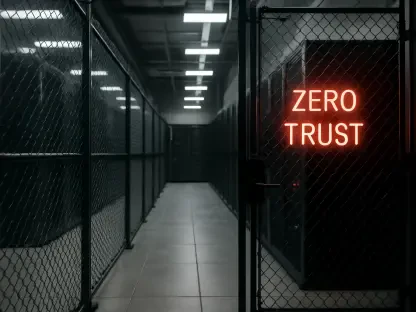Navigating the Digital Battlefield of Financial Oversight
Imagine a world where the guardians of financial stability, tasked with protecting billions in investments, find their own defenses breached by invisible adversaries who exploit the smallest vulnerabilities in their systems. This scenario unfolded recently for the Canadian Investment Regulatory Organization (CIRO), a pivotal body overseeing Canada’s debt and equity markets. A cybersecurity incident detected on August 11 exposed personal data of member firms and employees, spotlighting the fragility of digital fortifications in financial regulation. As cyber threats grow more sophisticated, the technology underpinning data protection in this sector faces unprecedented scrutiny. This review delves into the systems and strategies employed to safeguard sensitive information, using the CIRO breach as a lens to evaluate their effectiveness and resilience.
Analyzing Cybersecurity Technology in Financial Regulation
Detection and Response Mechanisms
At the heart of cybersecurity for financial regulators like CIRO lies the ability to detect intrusions swiftly and respond decisively. When the breach was identified on August 11, immediate action was taken to shut down affected systems, a critical step to halt further unauthorized access. This rapid response, while effective in containing initial damage, underscores the reliance on real-time monitoring tools and automated threat detection software. Such technologies are designed to flag anomalies, yet the incident reveals that even robust systems can be outmaneuvered by determined attackers, raising questions about the adequacy of current detection thresholds.
The subsequent investigation, supported by external cybersecurity experts, highlights the importance of forensic analysis tools in understanding breach vectors. These technologies dissect digital footprints to pinpoint vulnerabilities, though specific details about the compromised data remain undisclosed. This gap in transparency suggests a need for more advanced diagnostic systems that not only identify breaches but also provide detailed insights into the scope of exposure without delay.
Security Standards and Protective Measures
Financial regulators maintain stringent security standards, and CIRO is no exception, enforcing high benchmarks for itself and its members. Post-breach, proactive measures such as public warnings against fraudulent communications and temporary system shutdowns demonstrate a layered defense strategy. Encryption protocols, multi-factor authentication, and secure access controls are standard in such environments, yet the breach indicates potential lapses in implementation or updates to these safeguards.
Collaboration with law enforcement and legal advisors further integrates human expertise with technological solutions, ensuring a comprehensive response. However, the effectiveness of these measures hinges on continuous adaptation to evolving threats. The incident emphasizes that static security protocols, no matter how rigorous, can become outdated, necessitating dynamic tools like machine learning algorithms to predict and preempt cyber risks.
Impact Assessment and Stakeholder Protection
A critical feature of cybersecurity technology in this sector is its capacity to assess impact and protect stakeholders. CIRO’s commitment to identifying and notifying affected individuals, coupled with offering risk mitigation services, relies on data breach management software to track and categorize exposed information. These systems are essential for maintaining trust, yet their success depends on the speed and accuracy of data mapping, an area where delays can exacerbate damage.
Public reassurance that investments remain unaffected points to robust segregation of operational systems from administrative data. Technologies ensuring real-time equity market functions continue uninterrupted, even during a breach, showcase resilient infrastructure design. Nevertheless, the ongoing monitoring for compromised investor data suggests that current systems may lack preemptive safeguards to fully shield all stakeholder information from exposure.
Challenges and Limitations of Current Technology
Sophistication of Cyber Threats
One of the most pressing challenges for cybersecurity technology in financial regulation is keeping pace with the sophistication of modern cyber threats. Attackers employ advanced tactics, such as phishing schemes and ransomware, that exploit human error or outdated software. While firewalls and intrusion prevention systems form a first line of defense, their effectiveness wanes against zero-day exploits that target unpatched vulnerabilities, as potentially seen in the CIRO incident.
The rapid evolution of malware demands adaptive technologies, yet financial regulators often grapple with legacy systems slow to integrate cutting-edge solutions. This technological inertia creates blind spots, allowing breaches to occur before updates can be deployed. Addressing this requires not just investment in new tools but also a cultural shift toward proactive rather than reactive cybersecurity postures.
Balancing Transparency and Data Protection
Another hurdle lies in balancing transparency with data protection, a dilemma amplified by regulatory mandates. Technologies enabling secure communication and data sharing with stakeholders must also prevent overexposure of sensitive details during breach disclosures. CIRO’s cautious approach to revealing specifics about the breach reflects this tension, highlighting the need for systems that anonymize data while still facilitating necessary notifications.
Operational constraints further complicate this balance, as regulators must maintain public trust without compromising ongoing investigations. Current technologies often lack the flexibility to manage such dual objectives, suggesting a gap in tools designed for crisis communication. Developing platforms that streamline secure, transparent updates could mitigate this barrier significantly.
Verdict on Cybersecurity Technology in Financial Regulation
Reflecting on the CIRO breach, the evaluation of cybersecurity technology in financial regulation reveals both strengths and critical weaknesses. The swift detection and containment measures showcase the value of real-time monitoring and rapid response protocols, while stakeholder protection efforts underscore the importance of impact assessment tools. However, the incident also exposes vulnerabilities to sophisticated threats and the limitations of static security measures, painting a picture of a sector struggling to keep up with digital adversaries.
Moving forward, actionable steps emerge as essential for bolstering defenses. Financial regulators must prioritize integrating adaptive technologies like artificial intelligence for threat prediction and invest in modernizing legacy systems to close exploitable gaps. Collaboration with tech innovators to develop tailored solutions for secure, transparent communication during crises stands as a vital next step. Additionally, fostering a culture of continuous improvement in cybersecurity practices will be key to rebuilding trust and ensuring resilience against future attacks. The journey toward impenetrable digital fortresses in financial oversight continues, demanding unwavering commitment to technological advancement.









